
Setting a File Server
FTP technology, also used for the Internet, is used for sending files to a file server. FTP is a protocol for transferring files between computers.
 |
|
You can register a set file server to the Address Book so it can be specified as a destination for scanning to (Registering Address Book from Remote UI ).
To use PASV mode for FTP (Setting to use FTP PASV Mode).
|
 |
|
The use of Windows Server 2003/Server 2008/Vista/7/Server 2008 R2/8/8.1/Server 2012/Server 2012 R2 as an FTP server requires the installation of IIS. If IIS is not installed in the computer you are using, you will need to install the version of IIS for the operating system you are using before entering these settings. For installation procedures, see the manuals provided with your operating system.
User authentication for access to FTP servers is performed using the local account database of Windows Server 2003/Server 2008/Vista/7/Server 2008 R2/8/8.1/Server 2012/Server 2012 R2 used as the FTP server.
Therefore, it is not possible to use the account of a domain user registered in Windows Server 2003/Server 2008/Vista/7/Server 2008 R2/8/8.1/Server 2012/Server 2012 R2 to send data directly from the machine to FTP servers in other domains. |
Windows Server 2003/Server 2008/Vista/7/Server 2008 R2/8/8.1/Server 2012/Server 2012 R2
This section describes the procedures for using the default home directory under [Default FTP Site]/[FTP Sites]. To use other settings, enter the FTP site and home directory by referring to the IIS documentation.
It is recommended that you consult the administrator for the network you are using when configuring the FTP server.
In the following procedures, items displayed on the screens for Windows Vista/8 are used. Depending on your environment, the items you see on the screen may differ.
It is recommended that you consult the administrator for the network you are using when configuring the FTP server.
In the following procedures, items displayed on the screens for Windows Vista/8 are used. Depending on your environment, the items you see on the screen may differ.
1
Log on to Windows as a member of the group with access rights to the directory to be designated as the FTP site directory.
Depending on your environment, the access rights settings for a drive or directory may differ. For more information, see the Windows manual.
2
Start IIS.
Windows Server 2003: From the [Start] menu, select [Administrative Tools] - [Internet Information Services Manager].
Windows Vista/Server 2008: From the [Start] menu, select [Control Panel]. Double-click [Administrative Tools]  [Internet Information Services (IIS) Manager].
[Internet Information Services (IIS) Manager].
 [Internet Information Services (IIS) Manager].
[Internet Information Services (IIS) Manager].Windows 7/Server 2008 R2: From the [Start] menu, select [Control Panel]. Click [System and Security]  [Administrative Tools]
[Administrative Tools]  double-click [Internet Information Services (IIS) Manager].
double-click [Internet Information Services (IIS) Manager].
 [Administrative Tools]
[Administrative Tools]  double-click [Internet Information Services (IIS) Manager].
double-click [Internet Information Services (IIS) Manager].Windows 8/8.1/Server 2012/Server 2012 R2: Place the cursor on the top right (bottom right) of the desktop  select [Settings]
select [Settings]  [Control Panel]. Click [System and Security]
[Control Panel]. Click [System and Security]  [Administrative Tools]
[Administrative Tools]  double-click [Internet Information Services (IIS) Manager].
double-click [Internet Information Services (IIS) Manager].
 select [Settings]
select [Settings]  [Control Panel]. Click [System and Security]
[Control Panel]. Click [System and Security]  [Administrative Tools]
[Administrative Tools]  double-click [Internet Information Services (IIS) Manager].
double-click [Internet Information Services (IIS) Manager].3
Set the FTP site.
If you are using Windows Server 2003/Vista/Server 2008:
|
1
|
Right-click the [FTP Site] icon
 click [Properties]. click [Properties].In Windows Server 2003, the [Default FTP Site] icon is in the [FTP Sites] folder.
|
|
2
|
In the [FTP Site Properties] dialog box, click the [Security Accounts] tab.
In Windows Server 2003, perform the above operation in the [Default FTP Sites Properties] dialog box.
|
|
3
|
Deselect [Allow only anonymous connections].
|
|
4
|
Click the [Home Directory] tab
 select both [Read] and [Write] select both [Read] and [Write]  click [OK]. click [OK].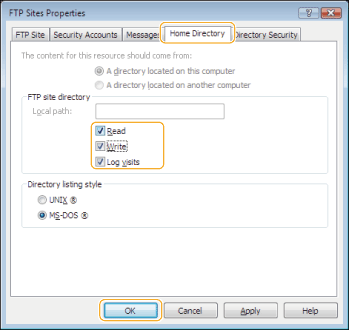 |
If you are using Windows 7/Server 2008 R2:
|
1
|
Right-click the [Sites] icon
 click [Add FTP Site]. click [Add FTP Site]. |
|
2
|
Enter the appropriate site information in the [Add FTP Site] dialog box
 click [Next]. click [Next]. |
|
3
|
Specify the binding and TLS settings respectively
 click [Next]. click [Next]. |
|
4
|
Deselect [Anonymous] for [Authentication].
|
|
5
|
Select both [Read] and [Write] for [Permissions]
 click [Finish]. click [Finish]. |
If you are using Windows 8/8.1/Server 2012/Server 2012 R2:
|
1
|
Right-click the [Sites] icon
 click [Add FTP Site]. click [Add FTP Site]. |
|
2
|
Enter the appropriate site information in the [Add FTP Site] dialog box
 click [Next]. click [Next]. |
|
3
|
Specify the binding and TLS settings respectively click [Next].
|
|
4
|
Deselect [Anonymous] for [Authentication].
|
|
5
|
Set the user/group whom you want to give access to the FTP site in [Allow access to].
|
|
6
|
Select both [Read] and [Write] for [Permissions]
 click [Finish]. click [Finish].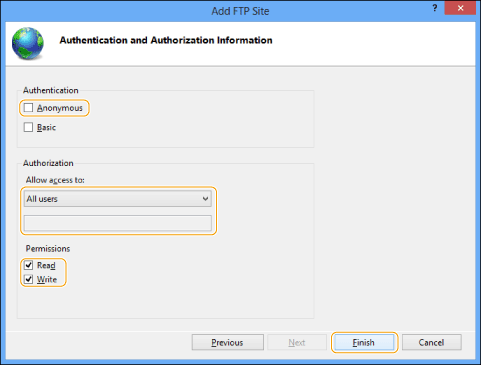 |
4
Confirm the full computer name.
5
Set the user and password for accessing the FTP server.
|
1
|
Display the window for managing the computer.
Windows Server 2003: From the [Start] menu, right-click [My Computer]
 select [Manage]. select [Manage].Windows Vista/Server 2008/7/Server 2008 R2: From the [Start] menu, right-click [Computer]
 select [Manage]. select [Manage].Windows 8/8.1: Right-click on the start screen
 select [All apps]. Right-click [Computer] or [This PC] select [All apps]. Right-click [Computer] or [This PC]  select [Manage]. select [Manage].Windows Server 2012/Server 2012 R2: Place the cursor on the bottom left of the desktop and right-click
 select [Computer Management]. select [Computer Management]. |
|
2
|
Double-click [Local Users and Groups] for [System Tools] in the [Computer Management] window.
If you are using Windows Server 2008/Server 2008 R2, double-click [Configuration] under [Server Manager].
|
|
3
|
Right-click the [Users] folder
 click [New User]. click [New User].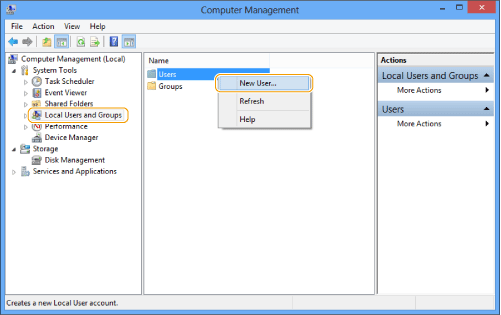 |
|
4
|
In the [New User] dialog box, enter the user name in [User name]
 enter the password in [Password] enter the password in [Password]  reenter the password in [Confirm Password] reenter the password in [Confirm Password]  click [Create]. click [Create].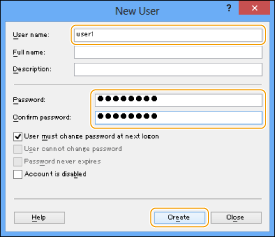 Set a user name not longer than 20 alphanumeric characters, and a password not longer than 32 alphanumeric characters.
If you select [User must change password at next logon], any new users added must change their passwords in order to send data from the machine. (You cannot change the password from the control panel.)
 In the Active Directory environment, the procedures for setting up users differ from the above. For more information, see the Windows manual.
|
UNIX/Linux
In some environments, detailed settings may be required in order to use FTP. For details, consult the administrator for the network you are using.
1
Log in to a workstation as a superuser  set up the users who send documents from the machine, and their passwords.
set up the users who send documents from the machine, and their passwords.
 set up the users who send documents from the machine, and their passwords.
set up the users who send documents from the machine, and their passwords.Enter a user name and a password no longer than 32 alphanumeric characters.
2
Create a shared directory to be used for recipient addresses, and then enable read access and write access by the users who will be sending data.
Mac OS X 10.7 - 10.9
 |
|
Screenshots and item names from Mac OS X 10.8 are used for the procedures common to each OS.
When changing your computer's settings, it may be necessary to unlock the computer by clicking the key icon.
|
1
Log in to Mac OS X as an administrator.
2
Start the FTP service on Mac OS X.
Mac OS X 10.7/10.8
|
1
|
Click [Go]
 [Applications] [Applications]  [Utilities]. [Utilities]. |
|
2
|
Double-click and start [Terminal].
|
|
3
|
Execute the following command.
sudo launchctl load -w /System/Library/LaunchDaemons/ftp.plist
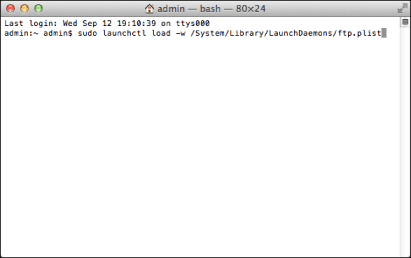 |
3
Set the user and password for sending the data.
|
1
|
Click [Accounts]/[Users & Groups] in the [System Preferences] window.
|
|
2
|
In the [Accounts]/[Users & Groups] window, enter the name of the user to whom you want to send data from the machine through Mac OS X
 enter the password. enter the password.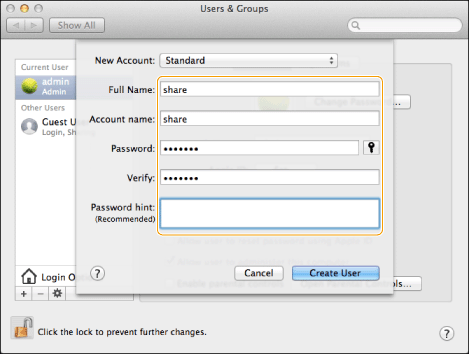 |
4
Create a shared folder to which files are to be sent.
Sample setting:
Create a folder named "FTP_Folder" (customizable) in [Go] - [Home] - logged in user name - [Public] - [Drop Box].
Create a folder named "FTP_Folder" (customizable) in [Go] - [Home] - logged in user name - [Public] - [Drop Box].
5
Set the access permissions for the shared folder created in step 4.
|
1
|
With the shared folder selected, click [Get Info] from the [File] menu.
|
|
2
|
Display [Sharing & Permissions].
|
|
3
|
Allow Read/Write for [Privilege].
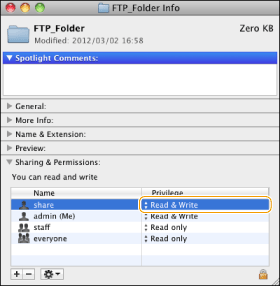 |
 |
|
If you are using Windows Vista, a dialog box may appear while you are performing the procedure. In this case, enter a user name and password. For more information, see the manuals provided with the operating system.
|